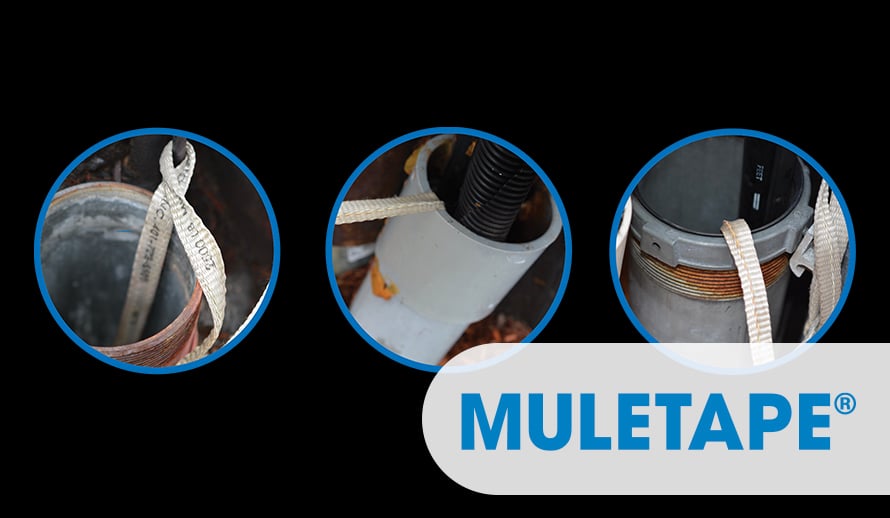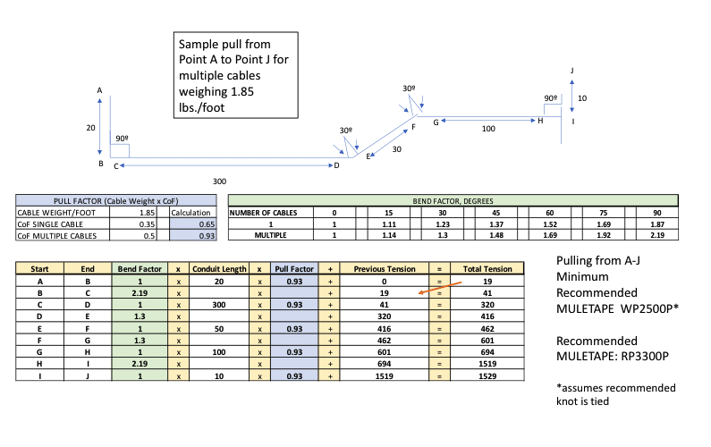 Our customers often ask us to recommend a MULETAPE, a product created by NEPTCO nearly four decades ago, for their applications. There are a number of factors that go into our recommendations. Cable weight is the biggest influence, followed by the number of bends and finally the conduit size. All of these variables contribute to pulling tension and MULETAPE recommendations.
Our customers often ask us to recommend a MULETAPE, a product created by NEPTCO nearly four decades ago, for their applications. There are a number of factors that go into our recommendations. Cable weight is the biggest influence, followed by the number of bends and finally the conduit size. All of these variables contribute to pulling tension and MULETAPE recommendations.
Pulling tension is a cumulative calculation with each bend in the conduit run contributing to more drag as the pull goes on. It is important to consult the cable manufacturer’s specifications for the maximum pulling tension before installing the cable. If pulling tensions are more than the maximum recommended limit, an intermediate pull box or manhole will need to be placed. MULETAPE is offered in tensile strengths varying from 400 to 6000 lbs.
We are happy to share our institutional knowledge along with a pulling tension calculation guide.
Cable that is duplexed, triplexed or quadraplexed at the manufacturer behaves differently from pulling a group of single cables. Multiplexed cable produced by the manufacturer is generally more tightly bound and behaves like a single cable during the pull, resulting in an easier pull.
Finally, the weakest point of MULETAPE is the knot, and a poor knot can severely impact the tensile performance of the pulling tape. We recommend a MULEKNOT™ or blood knot, which can provide 80% of the rated tensile strength of MULETAPE.
Notes for using the pulling tension guide
- Duplexed, triplexed or quadraplexed cable from the manufacturer should be treated as single cable.
- The simultaneous pulling of multiple single cables is defined as a multi-cable pull.
- The maximum pulling tension for bends for a single cable is 500 lbs. per foot radius multiplied by a typical 3-foot bend. (500 x 3 = 1500 lbs. Nominal).
- The maximum pulling tension for bends for a single cable is 1000 lbs. per foot radius multiplied by a typical 3-foot bend. (1000 x 3 = 3000 lbs. Nominal).
- Pulling eyes and grips have different rated strengths. Be sure to consult the manufacturer’s specifications.
- Conduits should be cleaned before placing cable.
- Cable lubricants should be used in accordance with the manufacturer’s recommendations.
- The coefficient of friction example that follows assumes a PVC conduit sized per the cable manufacturer’s recommendations.
- Single cable coefficient of friction = .35
- Multiple cables coefficient = .5
- Bend angle will impact drag. The following table should be consulted to complete the calculations.
|
|
Bend Factor, Degrees |
||||||
|
0 |
15 |
30 |
45 |
60 |
76 |
90 |
|
|
Single |
1 |
1.11 |
1.23 |
1.37 |
1.52 |
1.69 |
1.87 |
|
Multiple |
1 |
1.14 |
1.3 |
1.48 |
1.69 |
1.92 |
2.19 |
It should be noted that pulling tension can vary on the same pull. It is important to determine the starting point that will exert less strain on the cable. Usually, lower tension can be achieved by placing the cable reel closer to the shortest 90-degree bend. It might be helpful to make a sketch of the conduit run, showing bends.
The following is an example of a 460-foot pull of a 3 single conductor #2 15kV in 4” PVC conduit. The cable weighs 1.85 lbs. per foot. Please note the tension changes depending on the starting point of the pull.


As you can see from the examples above, pulling from point J to A results in a lower overall pulling tension; consequently, assuming the recommended knot is tied, a lighter duty MULETAPE can be used to complete the job.
To apply these formulas in your application, follow these steps:
- Determine the weight per foot of your cable.
- Multiply the weight by the coefficient of friction for either single cable or multiple cables to determine the pull factor.
- Sketch the pull and determine the lengths between bends.
- Multiply the bend factor by the length of conduit.
- Multiply the result by the pull factor.
- Add the resulting tension to the next length of conduit and repeat steps 2-5.
- Repeat step 6 until the last point results in the cable exit.
- Determine if the tension is lower if the cable is pulled from the opposite end by repeating the same steps from the other end.





